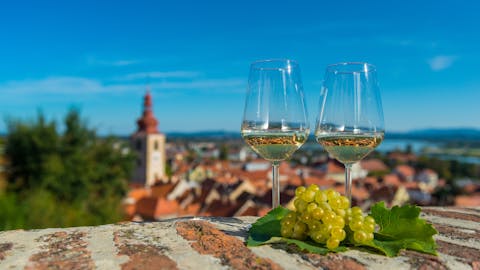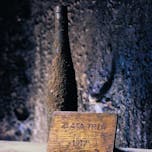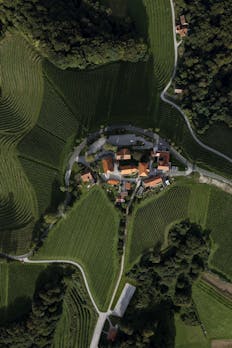
Wine and cuisine
Štajerska is a treasure trove of culinary traditions. From delicious desserts to hearty saar dishes, Štajerska cuisine presents a combination of local ingredients and respected culinary techniques. Let's join the culinary journey through this destination and find out its varied tastes. Štajerska has a long tradition of wine making.
Maribor is the city of the oldest vine in the world and is the best culinary destination of 2023! The 450-year-old vine, which grows in the oldest part of Maribor, symbolises excellent local providers – including internationally renowned winemakers and chefs with Michelin recommendations – and invites them to the unique gastronomic experiences of the Štajerska capital.
In the oldest town in Slovenia, in the Ptuj Cellar, the oldest wine cellar in Slovenia, a very special treasure is kept: the oldest Slovenian wine, the Golden Vine.



Meet the winemakers of the Association vinorodna Štajerska. The association is a stand-alone and independent organisation of winegrowers who have teamed up to jointly promote the wine-growing district in which they operate.
The aim of the association's activities is to raise the visibility and reputation of the wine-growing district of Štajerska Slovenija and to place on the world wine map the best wine-growing regions and to improve the visibility of the district as a wine destination with a quality wine tourist offer.


Famous wine varieties such as shipon, Laški riesling and sauvignon impress even the most demanding wine lovers. The region's vineyards thrive in fertile soil and a unique microclimate, creating exceptional wines that fit perfectly with local cuisine.
Štajerska is known for its diverse selection of sweet treats that pamper the palate. Traditional dishes such as cooked dumplings, apple strudel, gibanica, walnut potica, fruit bread, ... These sweet delights highlight the skill and creativity of local bakers.
When we offer a good shipon, the excellent one, late in autumn torn chipo, almost everyone, a slead or an ignorant drinker, enthusiastically nods. Great wine! Why is this the case, even if people try this wine for the first time in their lives, whose name is hard to get off their tongues at first?
Šipon is distinguished by its pleasant fruity smell (ripe pineapple), the stuffing of green almonds, hazelnuts, even mowed grass and seine, or maybe someone's smell even resembles olive oil and a fish floating in it!


The daily cuisine of Štajerska offers a diverse range of dishes that reflect the agricultural heritage of the region. Traditional dishes include bean dishes, various types of žganci, heart stews, nutritious soups, sauerkraut, turnips, stewed cabbage, buckwheat and millet porridge. These hearty dishes provide comfort and nutritiousness and often include locally grown ingredients.
Exploring the culinary wonders of Štajerska is an opportunity to experience the untouched beauty of nature. Tourist farms and local producers in the region offer carefully selected, organic and naturally grown ingredients that awaken the palate. These ingredients form the basis of the culinary traditions of Štajerska , which combine tradition with modern and world flavors.
The grape harvests wrapped up in October. In the first days of November, our towns quite literally come to life. For us, St. Martin’s Day is the biggest local holiday—rooted in tradition, viticulture, and winemaking—filled with gratitude and joy for everything we have grown and experienced throughout the year.


A culinary gem of Štajerska is pumpkin seed oil. Its unique aroma, distinctive taste, and appealing appearance make it an indispensable ingredient in the Prlekija kitchen. The region’s long history of pumpkin cultivation has led to the development of various pumpkin varieties, each with its own shape, color, size, and flavor. Pumpkin seed oil made from the golica (hulless) variety is obtained by pressing the seeds and has a rich, nutty taste. Its intensely green hue, with hints of red, is characteristic of Slovenian pumpkin seed oil—and truly magical for the senses.
Pumpkins are a very old cultivated plant, and over the centuries people have bred many varieties that differ in shape, color, size, and, not least, flavor.
It is precisely the golica pumpkin from which, today just as a hundred years ago, we obtain pumpkin seed oil. It takes 2.8 kg of dried seeds to press one liter of this precious, thick oil.


Štajerska culinary traditions offer a tempting array of flavors that celebrate the region’s natural bounty. From traditional sausages and pastries to hearty stews and aromatic wines, Štajerska cuisine serves up a rich tapestry of tastes and experiences. Exploring Štajerska culinary delights is a journey that blends tradition with innovation, creating a vibrant and unforgettable gastronomic adventure.
Meat from tünka is likewise a renowned culinary specialty. Records indicate it has been prepared in this area since the 15th century. The base is suitably sized, prime cuts of pork, which masters salt and submerge in brine for 14 days.





